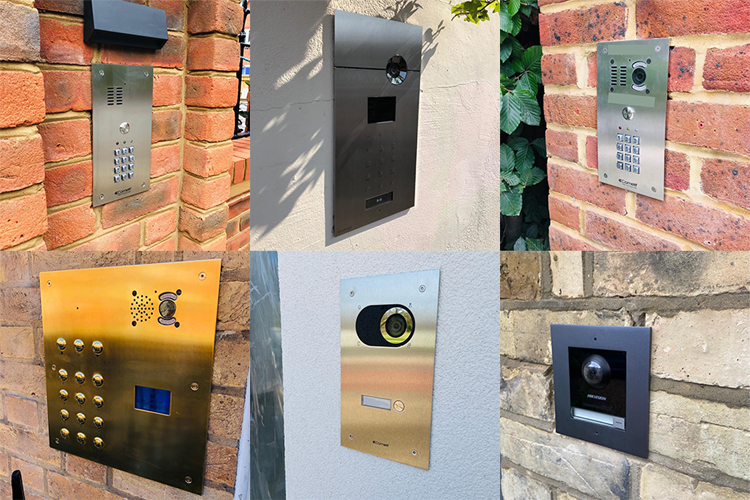

Door entry refers to the process of allowing or preventing access to a specific area or building through the use of an intercom or other communication system. The system allows for communication between the person outside the building and the person inside, and can be used to open the door or gate remotely. Door entry systems are typically used to control access to residential or commercial buildings, the technology used can be 2-wire, IP or GSM based.
What it is: A 2-wire door entry system typically consists of two main components: an outside intercom station and an inside intercom station. The outside station is mounted at the entrance to the building or room and includes a button for calling the inside station, as well as a microphone and speaker. The inside station includes a speaker and microphone, as well as a button for unlocking the door.
How it works: The two stations are connected by two wires (hence the name “2-wire” system), which transmit the audio, video and data signals between the two units. When a person outside the building presses the call button on the outdoor unit, it sends a signal to the indoor unit, which causes the speaker to ring. The person inside the building can then press the call button on the indoor unit to open a two-way audio communication with the person outside the building.
Benefits: The system is simple and easy to install, making it a cost efficient option, especially if you are using the existing cabling.
Most commonly used for: Residential and small commercial applications because it is simple to install, easy to use and cost-effective. We can re-use the existing cabling infrastructure, which means they are perfect for system upgrades, including upgrading from an audio only system to a video door entry system.
What it is: An IP-based door entry system is a type of intercom system that uses the Internet Protocol (IP) to connect the various components and enable communication and control. This means that the system uses a network, typically a LAN (Local Area Network) or a WAN (Wide Area Network), to connect the door entry stations, monitors, and other devices, allowing them to communicate and share information.
How it works: The main components of an IP-based door entry system are similar to those of a traditional 2-wire system, including an outside intercom station and an inside intercom station. However, in an IP-based system, these stations are connected to the network using Ethernet cables or Wi-Fi, rather than traditional wiring.
Benefits: One of the key advantages of an IP-based door entry system is the ability to remotely access and control the system using a computer or smartphone. For example, you can use a web browser or mobile app to see who is at the door, communicate with the person, and unlock the door remotely. Additionally, IP-based systems are incredibly flexible and scalable, and can be integrated with other building systems, such as access control, security cameras, and building management systems, providing a more complete and secure access solution.
Most commonly used for: IP-based door entry systems are more flexible and scalable than traditional 2-wire systems. We use them for a wide range of projects from simple one-user system, to larger sites such as offices, multi-tenant buildings, gated communities, and other types of commercial and residential buildings.
What it is: A GSM-based door entry system is a type of intercom system that uses the Global System for Mobile Communications (GSM) network to connect the various components and enable communication and control.
How it works: The main components of a GSM-based door entry system are similar to those of a traditional 2-wire system and an IP-based system. However, in a GSM-based system, these stations are connected to the GSM network using a SIM card and a GSM modem, rather than traditional wiring or Ethernet cables.
Benefits: One of the key advantages of a GSM-based door entry system is that it does not require a fixed telephone or internet line to work, as it uses a mobile network to communicate. This makes it more flexible and portable, allowing you to install the system in locations where traditional phone or internet lines are not available. Additionally, GSM-based systems can be accessed remotely using a telephone or a mobile app, allowing you to see who is at the door, communicate with the person, and unlock the door remotely.
Most commonly used for: Installations where there is no existing cabling and it isn’t possible to run new cables. Whilst a GSM-based door entry system is more flexible and portable than traditional 2-wire and IP-based systems, it does require a reliable GSM signal and a SIM card with a data plan to operate. It also requires a power source to operate, and it can be affected by weak signal strength or network congestion.

We partner with a range of manufacturers, depending on the project requirements, our go-to partners are Comelit, Hikvision and Intratone.
If you would like to discuss your door entry requirements or any other security solutions, get in touch.
Check out our other blog posts here.